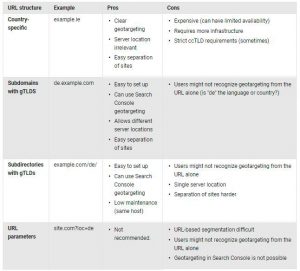International-Multilingual SEO Basics
Open the door to new revenue!
Are you thinking about expanding your business into a new market (e.g. a different country or language)? International – Multilingual SEO can help you to reach your target market in the chosen countries/languages, but it requires some resources and planning.
The current visibility of your website in the target country will determine the number of resources and the time required in terms of SEO. A website with higher visibility and traffic will require fewer resources than a website that receives zero traffic from the specific country.
Are you already receiving traffic from other countries?
- You can find out via your Analytics account:
Audience > Geo > Locations
- Or you can go to Search Console. There you can filter the search queries by country:
Search Traffic > Search Analytics
Market Potential
Once you have identified the country or countries you want to expand your business to, before investing, you need to know the potential of this market.
The first step is searching for specific keywords that your target audience might use to search for your product or services; then determine the search volume and competition around them, and how you are already positioned.
You should then decide if the existing searches are enough to invest in this country. If the products/services which you offer are not well known and have no searches, you will need to create awareness first. On the other hand, you can target solely the language, which will bring you more reach.
In addition, you should determine who your main competitors are and how they are performing, by carrying out a competitor analysis.
Then you will know how difficult it will be to conquer this new market and if it is worth investing in International – Multilingual SEO.
Target Market
Think global, act locally!
Now we know which countries/languages could be potentially lucrative. But who are your customers/clients there, how do they purchase, do they buy online, what are the cultural differences, do they buy via mobile devices, etc.?
It is highly important to know the particularities of your target market in the new country, and if possible, create a target persona.

Site architecture and technical considerations when doing International – Multilingual SEO
So we are all set, we know which country or language we are going to target and our target persona/s. So let’s start with some basic technical requirements for our site to be found and shown to the right audience.
When having a multilingual website, apart from common technical SEO checks (as Speed, robots.txt, sitemaps, redirects, 404 errors, etc.), we need to take into consideration a few more technical specifications.
1.URL Structure
When performing International – Multilingual SEO, URL structure is one of the first elements to take into consideration. It is important to use the best structure to let search engines see your content more effectively. To start, if you’re trying to target different languages, each one needs to have their own URL. However, there are different ways to achieve this, each of them with its pros and cons as defined by Google on the image below.
- Country-specific domain
- ccTLD
- Subdomain
- Subdirectory

Source: httpss://support.google.com/webmasters/answer/182192?hl=en&ref_topic=2370587#1
2.Hreflang
“Hreflang” is the second critical element when performing International – Multilingual SEO. “Hreflang” helps search engines show the right content to the right users (taking into consideration the specified language and country).
Regardless of the URL structure that you have chosen, “hreflang” implementation is needed. If you are wondering if it can also be applied when using different domains, then yes it is possible.
To start, when creating the “hreflang” annotations, it is necessary to use the correct coding for the language and country. Both language and country are represented by two letters, following the below ISOs:
- Language: ISO 639-1
- Country: ISO 3166-1 Alpha 2
If the language and country code are not following these mentioned ISOs, Google will not recognise them and won’t be able to show the correct version of your site.

While using “hreflang” you can target just the language, or both the language and the country.
- Targeting just the language
The code below will target the Spanish language.
<link rel=”alternate” hreflang=”es” href=https://example.com/es/>
- Targeting the language and country
The code below will target Spanish speakers in Spain.
<link rel=”alternate” href=”https://example.com/es-es” hreflang=”es-ES” />
- Default version
Google also offers the possibility to assign a default version, for the rest of the countries / languages not specified on the “hreflang”.
Let suppose you are an Irish Company thinking about expanding to Spain. You have decided that your URL structure will be subfolders. What will then be the correct “hreflang”? It all depends on your strategy. See below for a couple of possible options.
Option 1
https://example.com/es-es > For Spanish speakers in Spain
https://example.com/en > For English speakers in any country
Hreflang
<link rel=”alternate” href=”https://example.com/es-es” hreflang=”es-ES” />
<link rel=”alternate” href=”https://example.com/en” hreflang=”en” />
Option 2
https://example.com/es-es > For Spanish speakers in Spain
https://example.com/en-ie > For English speakers in Ireland
https://example.com/en-gb > For English speakers in the United Kingdom
Hreflang
<link rel=”alternate” href=”https://example.com/es-es” hreflang=”es-ES” />
<link rel=”alternate” href=”https://example.com/en-ie” hreflang=”en-IE” />
<link rel=”alternate” href=”https://example.com/en-gb” hreflang=”en-GB” />
Once you have chosen your strategy and have created the right “hreflang” combination, you need to add this combination to each of the pages. For example, if we take into consideration the first two pages in Option 2, we will need to implement as follows:
Spanish version: https://example.com/es
<link rel=”alternate” href=”https://example.com/es” hreflang=”es” />
<link rel=”alternate” href=”https://example.com/en-IE” hreflang=”en-IE” />
<link rel=”alternate” href=”https://example.com/en-GB” hreflang=”en-GB” />
English – Ireland version: https://example.com/en-IE
<link rel=”alternate” href=”https://example.com/es” hreflang=”es” />
<link rel=”alternate” href=”https://example.com/en-IE” hreflang=”en-IE” />
<link rel=”alternate” href=”https://example.com/en-GB” hreflang=”en-GB” />
This way, when Google bots crawl one of the versions it will know which are the remaining languages/countries versions.
If one of the versions does not exist for one specific page, for example, there is no Spanish version, do not include the URL on the “hreflang” annotations. Also, do not include “hreflang” annotations on pages that you don’t want Google to index.
Implementation of hreflang
There are three ways to implement it:
- Sitemap with all variations for each URL
- On-page markup on the head of the page
- HTTPS Header
Hreflang and duplicate content
In the case of duplicate content and the need for a canonical tag, just the original URL needs to have the hreflang annotations. The duplicate URL should only contain the canonical tag.
- https://example.com/es/page1 > original URL
The original URL will contain the “hreflang” annotations. Also, you should add the self-referencing canonical as suggested by Google.
<link rel=”alternate” href=”https://example.com/es/page1″ hreflang=”es” />
<link rel=”alternate” href=”https://example.com/en-IE/page1″ hreflang=”en-IE” />
<link rel=”alternate” href=”https://example.com/en-GB/page1″ hreflang=”en-GB” />
<link rel=”canonical” href=”https://example.com/es/page1/”>
- https://example.com/es/page2 > duplicated URL
The duplicated URL will contain just the canonical tag pointing to the original URL:
<link rel=”canonical” href=”https://example.com/es/page1/”>
Language, Content, and Localisation
A big part of the International – Multilingual SEO is creating relevant content for the new target market. We need to write content that is appealing to them. For this reason, the use of automatic translation is never advised for your site. You will require a native speaker who can write content using the correct words and localised expressions.
An example of how content can be adapted are these movie titles from Spain:
- Flintstones > Los Picapiedra (The stone beaters)
- Airplane > Aterriza como puedas (Land how you can)
- The Wonder Years > Aquellos maravillosos años (Those wonderful years)

- The parent trap > Tú a Londres yo a California (You to London and myself to California)
- Beetlejuice > Bitelchus
- The Fast and the Furious > A todo Gas (Full Speed)
- And many more surreal names!
The seasonality and weather it is also important, for example, Irish users may be looking for coats online while in some areas of Spain, users may still be looking for bikinis.
Which are some popular topics? While Connor McGregor might be well known among Irish users, almost no one will know him in Spain.

Analysing the content, from you and your competitors, which resonates the most with your target audience will help you to move in the right direction.
Linking and Social
Having the correct structure and localised content in place is not always enough to appear in front of your target audience. As with any type of SEO, in International – Multilingual SEO links are essential. In this case, the majority of those links need to come from the chosen country/language. So a targeted link building strategy needs to be in place for each of the new countries/languages that you wish to conquer.
If you have a local physical location, it would be beneficial to create a local Google My Business account.
Moreover, you need to know which Social Media channels your new target market use and who are their influencers – as Social Media signals are also beneficial.
Some other International SEO resources:
- Getting hreflang Right: Examples and Insights for International SEO (David Sottimano)
- International guidelines Google
- How to implement hreflang with Google Tag Manager (Eoghan Henn)
- The hreflang Tags Generator Tool (Aleyda Solis)
- The 15 Most Popular Myths About International SEO, Debunked (Kaitlin McMichael)

In conclusion, think about everything that targeting new countries or languages implies before jumping straight into it. As with any kind of SEO project, it takes time and will require resources. So always take this factor into consideration.

Leave a Reply